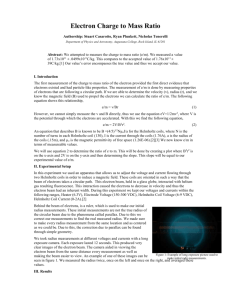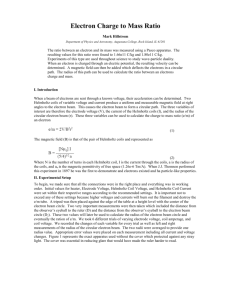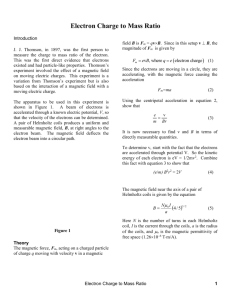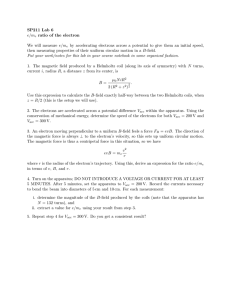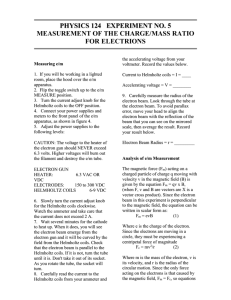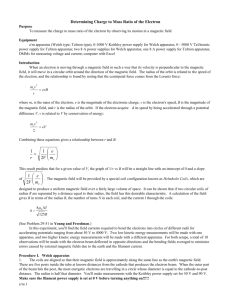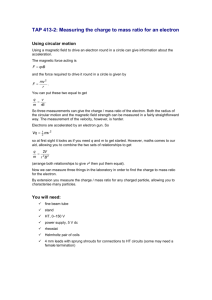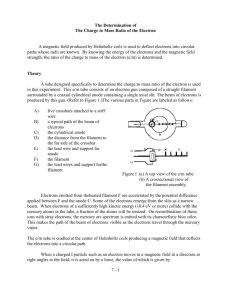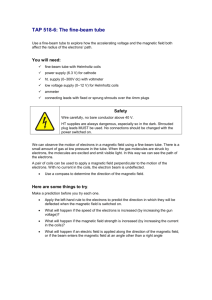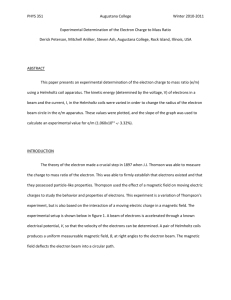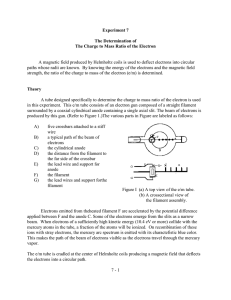e/m lab instructions
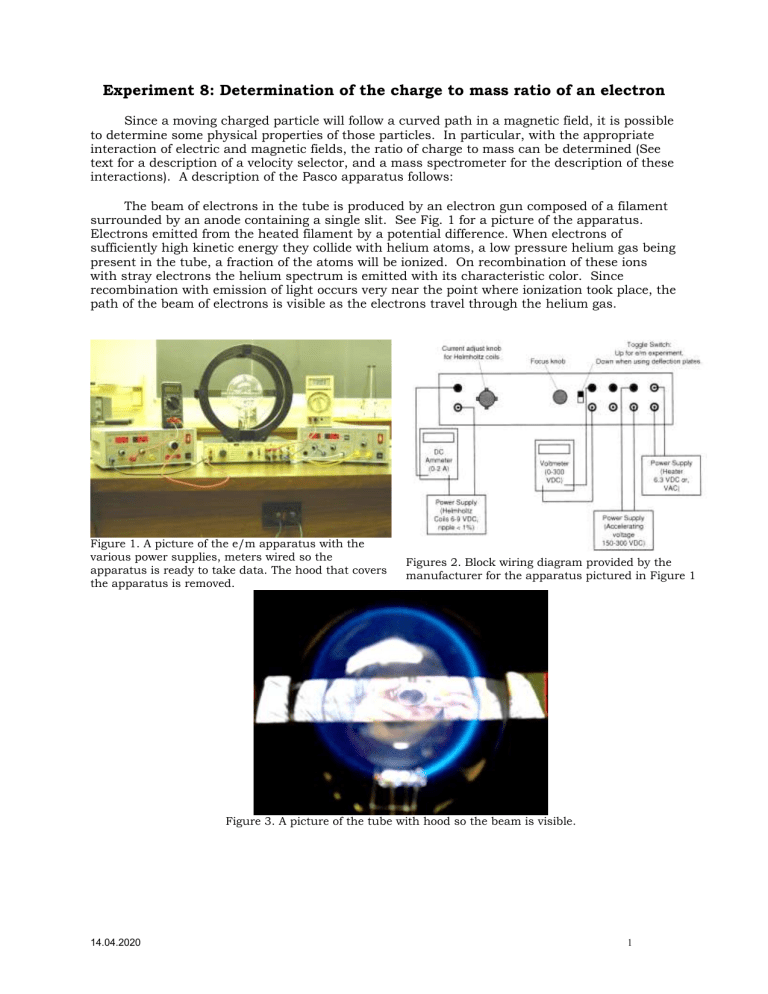
Experiment 8: Determination of the charge to mass ratio of an electron
Since a moving charged particle will follow a curved path in a magnetic field, it is possible to determine some physical properties of those particles. In particular, with the appropriate interaction of electric and magnetic fields, the ratio of charge to mass can be determined (See text for a description of a velocity selector, and a mass spectrometer for the description of these interactions). A description of the Pasco apparatus follows:
The beam of electrons in the tube is produced by an electron gun composed of a filament surrounded by an anode containing a single slit. See Fig. 1 for a picture of the apparatus.
Electrons emitted from the heated filament by a potential difference. When electrons of sufficiently high kinetic energy they collide with helium atoms, a low pressure helium gas being present in the tube, a fraction of the atoms will be ionized. On recombination of these ions with stray electrons the helium spectrum is emitted with its characteristic color. Since recombination with emission of light occurs very near the point where ionization took place, the path of the beam of electrons is visible as the electrons travel through the helium gas.
Figure 1. A picture of the e/m apparatus with the various power supplies, meters wired so the apparatus is ready to take data. The hood that covers the apparatus is removed.
Figures 2. Block wiring diagram provided by the manufacturer for the apparatus pictured in Figure 1
14.04.2020
Figure 3. A picture of the tube with hood so the beam is visible.
1
The magnetic field of the Helmholtz Coils causes the stream of electrons to move in a circular path the radius of which decreases as the magnetic field increases.
Each coil of the pair of Helmholtz Coils has
130 turns
of copper wire and a separation and a mean radius of 15 cm .
A lighted mirrored scale behind the tube allows measurement of the radius of the beam.
Theory: A charged particle moving in a uniform magnetic field experiences a radial force which has a magnitude of
F = evB =
2 v
m r
1 where e and m are the charge and mass of the electron, v is the velocity of the particle, and r is the radius of the beam.
The electron is originally accelerated in the electron gun by the potential difference V between the cathode (filament) and anode. Thus the electron has a kinetic energy
1
2 mv =eV
Combining the two equations, and solving for e/m yields
2V
2 2
B r
The magnetic field generated by the Helmholtz Coils is given by
2
3
B =
8μ o
NI
5 5 a
4 where o
is the magnetic permeability of free space, N is the number of turns of one coil, I is the current through the coils, and a is the mean radius of the coil. (PLEASE NOTE: All units in the above equations are SI units.)
Combining equations (3) and (4) yields
125a
2
2 2
32μ N o
V
I r
5
14.04.2020
2
PROCEDURE:
1. Be sure the switch on the e/m apparatus is switched to e/m MEASURE.
2. Turn the current know for the Helmholtz coils to the OFF position.
3. Connect your power supplies and meters to the front panel of the e/m apparatus as shown in Figures 1 and 2.
4. Adjust the power supplies to the following values:
CAUTION: The voltage to the heater of the electron gun should NEVER exceed 6.3 volts.
High voltages will burn out the filament and destroy the e/m tube.
ELECTRON GUN HEATER:
ACCELERATING ELECTRODES
6.3 VAC
175 to 275 VDC (see below)
HELMHOLTZ COILS 8.5 VDC
5. Choose a voltage for the accelerating electrode (you will eventually choose a second value).
6. Slowly turn the current adjust knob for the Helmholtz coils clockwise. Watch the ammeter and take care that the current does not exceed 2 A.
7. Wait several minutes for the cathode to heat up. When it does, you will see the electron beam emerge from the electron gun and it will be curved by the field from the Helmholtz coils. Check that the electron beam is parallel to the Helmholtz coils. If it is not, turn the tube until it is. Don’t take the tube out of its socket. As you rotate the tube, the socket will turn.
8. Record the current through the Helmholtz coils and the accelerating voltage.
9. Carefully measure the radius of the electron beam. Look through the tube at the electron beam. To avoid parallax errors, move your head until you align the beam with its reflection that you see in the mirrored scale. Read the scale on both the left and right side and then average your results to get the best value for the radius. Have your partner do the same thing and average the two results.
10. Change the radius of the beam by adjusting the current in the Helmholtz coils so the radius changes by about 0.2 cm. Repeat steps 9 and 10.
11. Continue as in step 10 for a total of 5 different radii for one accelerating voltage.
12. Change the accelerating voltage, and repeat the above procedure for another 5 radii.
13. When finished shut off the power supplies.
ANALYSIS:
Solve equation 5 for
I
1
2
.
Using a spread sheet program, and using r 2 as the independent variable (x-axis variables) and
I
1
2 as the dependent variable (y-axis variables), plot the data and determine the best straight line fit for one of the accelerating voltage. For this analysis set the y-intercept to zero
.
Show the linear fit on the graph. The slope is the coefficient of r 2 , and is proportional to e/m and inversely proportional to V. Solve for e/m. Repeat the analysis for the second value of V. Discuss your results. Your report should include appropriate error analysis.
14.04.2020
3

